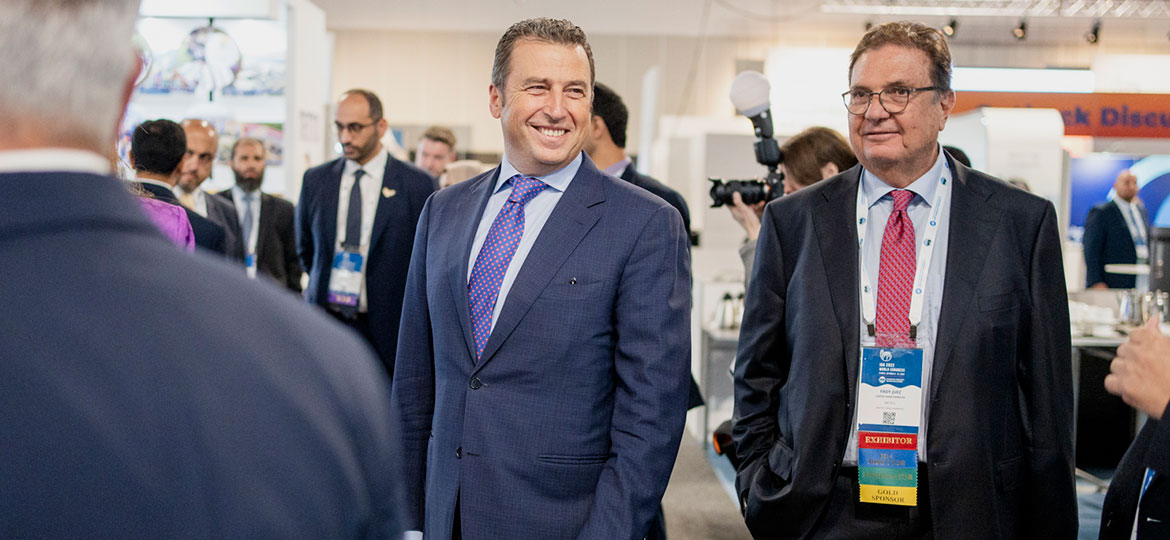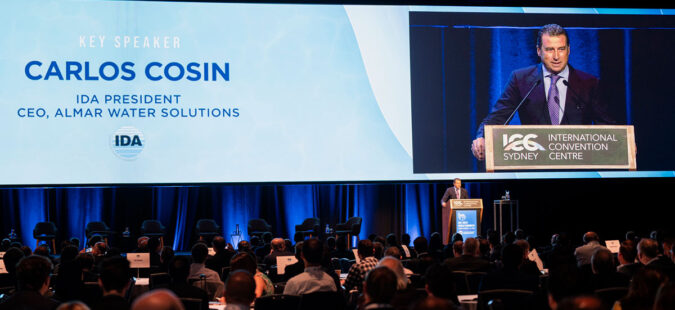
Interview to Carlos Cosin, Former IDA President
- Carlos Cosín was president of the International Desalination Association (IDA) from 2019 to 2022.
- Today, as he leaves office, we interviewed him about his assessment of his time as President and his vision of the future of the association.
Carlos Cosín is CEO of Almar Water Solutions and was elected President of the International Desalination Association (IDA) at the IDA 2019 World Congress held in Dubai. After three years in office, including an additional year due to the postponement of the event because of the COVID-19 pandemic, Carlos takes stock of his position as president and talks about the initiatives and projects that were carried out during this period.
During his time as President, Carlos Cosín was supported by Devesh Sharma, CEO of Aquatech International, as First Vice President, Alejandro Sturniolo, director of water reuse and strategic partnerships at H2O Innovation, as Second Vice President, and Shannon McCarthy as Secretary General of the association.

What is your assessment of your time as President of the International Desalination Association (IDA)?
I can’t separate my time as President from the previous phase; I prefer to see it as a continuation of my support for the Association. I have been a member of IDA since 1997, but I started to take a more active role when I joined the board four terms ago. During that time, together with the active board members, I have promoted essential changes in the management and direction of the association, including the change of the secretary general. Prior to serving as President, I held the position of treasurer, so we sought a more international profile and a CV adapted to the new situation and financial management. My goal with this change was to provide IDA with a higher level of management through the new secretary general, to elevate the level of the board with professionals in the sector who would contribute their experience and decision-making power in the companies they manage for the benefit of the sector, and to provide added value and content to IDA so that it would benefit all of its members. This is key for an Association whose financial sustainability is based on the fees paid by registered members and the sponsorships of the initiatives it carries out. Without that added value, the road would be a short one. We have also focused our efforts on new communication tools that give greater visibility to the tremendous work that is being done inside the Association.
This is a job that is done generously, without remuneration, and the members and the market itself are the ones who should take stock, not me. I have tried to contribute with my experience, and I have worked very well with the new board and of course side by side with Shannon McCarthy, our Secretary General who is the one who in the end is responsible for implementing the day-to-day work and the success of what has been achieved belongs to her.
One of your goals, when you were elected President of the IDA, was to broaden the viewpoint of the association, adapt it to the new reality, and move deeper into the areas of reuse and advanced technologies. How much progress did you make toward this goal?
Well, my idea was to adapt IDA to the new times. IDA enjoys a prestigious reputation in its technological profile; the technical presentations and publications that are presented at each and every congress always involve large technological advances and a lot of hard work to maintain the level that is expected. But the sector needed to adapt to the new challenges, contractual frameworks are enormously more complex with new models such as PPP and BOOT, with much more versatile and imaginative financing, and with many more players in the sector. We realized that what we were missing in the association was the end customer, the utilities, the big industrial consumers, which are the ones who demand and contract the projects from the developers or EPC contractors, and also an understanding of the new regulatory frameworks in order to help many countries to develop favorable frameworks. Lastly, non-conventional water resources (desalination and reuse) that used to be focused on municipal frameworks, now have a large presence in the industrial sector. Leading companies from industries such as Food and Beverage, Oil and Gas, or mining now form part of our Association.
We wanted to make room for all of these professionals and give them a place to contribute their comments, problems, and solutions. We created working groups called Advisory Committees, led by excellent leaders who are doing a very professional job. We are advancing little by little in this. We are a non-profit association, so we cannot compensate for the free contributions of these top professionals, who have limited time and busy calendars. I am aware that this will take time, but I think we have planted the seeds in the IDA’s new format. I would like to take this opportunity to thank everyone for their selfless contributions.
These working groups have generated very interesting initiatives that we are working on (some have already been announced) and that will bring great added value to the IDA of the future, as a leading player in the management of unconventional resources for the development of a sustainable future.

What is your vision for the sector and the future of desalination and reuse? How does it fit in with the renewable energy revolution?
Desalination continues to grow every year, technology is already a commodity and the scale effect has broken the molds, which means that there is no stopping its development. More and more countries are going to make use of this technology, and its challenges will lie more in the new replacement technologies or in the reduction of production costs. New ideas are being developed to eliminate or mitigate brine rejection and at the same time take advantage of the extraction of minerals for commercial use. That path is wide open and holds great potential. In all areas near the coast (less than 100km), with no alternative resource, desalination will have no competition.
Where we still have a long way to go is in reuse, which is key to replacing the use of fresh water and natural resources for agricultural irrigation and industrial water. These are the world’s biggest consumers and we have come a long way, but even so, in the next 10-15 years, we will certainly be seeing significant progress.
The use of renewable energies is growing in parallel with it, creating important synergies, and not specifically in the hybridization in our plants, where wind or sunshine don’t always generate the best performance. But where I do see great opportunities is in the production of hydrogen by electrolysis, because water is a critical resource for its production. I have no doubt as to the enormous potential that the sector will open up to us.
How do you see the role of desalination in the context of climate change?
Of course, since water is a resource that is scarce and that will remain critical in the future, desalination and reuse are the only ways to produce new water resources. This will enable us to preserve natural reserves, lakes, and rivers, maintain their ecological flows and avoid the overexploitation of aquifers to keep these reserves for future generations.
The United Nations has just recognized for the first time that the generation of unconventional resources (desalination and reuse) are a key tool in the fight against climate change. But I would like to go even further because reality is very stubborn. SDG 6, which guarantees the availability of water and its sustainable management and sanitation for all, is a challenge in and of itself but if it isn’t achieved, the other sustainable development goals such as eradication of poverty (SDG 1), food security (SDG 2), health and well-being (SDG 3), reduced inequalities (SDG 10) or development and economic growth (SDG 8) will simply not be possible if we fail to ensure water and sanitation for the future citizens of humanity.
The IDA has an enormous role and responsibility in this regard. Its contribution will be invaluable in facing this challenge. For my part, I will continue to serve on the board to the best of my ability, and I am sure that the new President, Fady Juez, together with the team of professionals and the secretary general at the front, will be able to carry this forward with great enthusiasm and even greater commitment.

